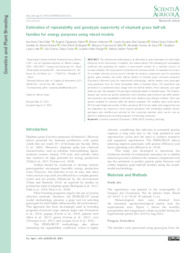Estimation of repeatability and genotypic superiority of elephant grass half-sib families for energy purposes using mixed models.
Estimation of repeatability and genotypic superiority of elephant grass half-sib families for energy purposes using mixed models.
Author(s): VIDAL, A. K. F.; DAHER, R. F.; AMBRÓSIO, M.; SANTANA, J. G. S.; FREITAS, R. S.; GRAVINA, G. de A.; RODRIGUES, E. V.; STIDA, W. F.; SOUZA, A. G. de; LEITE, C. L.; FARIAS, J. E. C.; RANGEL, L. H.; PEREIRA, A. V.
Summary: The mixed-model methodology is an alternative to select genotypes for traits highly influenced by the environment. In addition, this method allows FOR estimating the repeatability coefficient and predicting the number of assessments needed for a selection process to increase reliability. This study aimed to determine the minimum number of evaluations necessary for a reliable selection process and to estimate the variance components used for predicting genetic gains between and within half-sib families of elephant grass (Cenchrus purpureus (Schumach.) Morrone) using the mixed-model methodology. Half-sib families were generated using genotypes from the Active Germplasm Bank of Elephant Grass. The experiment was performed in a randomized block design with nine half-sib families, three replicates, and eight plants per plot. We evaluated 216 genotypes (individual plants) of elephant grass. The deviance analysis was carried out, genetic parameters were estimated, gains between and within families were predicted, and repeatability coefficients were obtained using Selegen software. There was genetic variability for selection within the families evaluated. The reliability values found above 60 % for plant height and number of tillers and above 80 % for dry matter yield suggest that only two evaluations are required to select superior genotypes with outstanding reliability. Sixteen genotypes were identified and selected for their productive potential, which can be used as parents in elephant grass breeding programs for bioenergy production.
Publication year: 2023
Types of publication: Journal article
Unit: Embrapa Dairy Cattle
Keywords: Bioenergia, Capim Elefante, Cenchrus purpureus, REML/BLUP
Observation
Some of Embrapa's publications are published as ePub files. To read them, use or download one of the following free software options to your computer or mobile device. Android: Google Play Books; IOS: iBooks; Windows and Linux: Calibre.
Access other publications
Access the Agricultural Research Database (BDPA) to consult Embrapa's full library collection and records.
Visit Embrapa Bookstore to purchase books and other publications sold by Embrapa.

